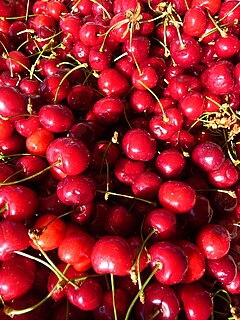
A cherry is the fruit of many plants of the genus Prunus, and is a fleshy drupe.

Prunus is a genus of trees and shrubs, which includes the fruits plums, cherries, peaches, nectarines, apricots, and almonds.

Prunus cerasus is a species of Prunus in the subgenus Cerasus (cherries), native to much of Europe and southwest Asia. It is closely related to the sweet cherry, but has a fruit that is more acidic. Its sour pulp is edible.

A cherry blossom is a flower of many trees of genus Prunus. The most well-known species is the Japanese cherry, Prunus serrulata, which is commonly called sakura.

Prunus padus, known as bird cherry, hackberry, hagberry, or Mayday tree, is a flowering plant in the rose family Rosaceae. It is a species of cherry, a deciduous small tree or large shrub up to 16 m tall. It is the type species of the subgenus Padus, which have flowers in racemes. It is native to northern Europe and northern Asia.

Prunus serrulata or Japanese cherry, also called hill cherry, oriental cherry, East Asian cherry, is a species of cherry native to China, Japan and Korea, and is used for its spring cherry blossom displays and festivals. Current sources consider it to be part of a species complex with P. jamasakura and P. leveilleana, which have been reduced to synonyms.

Taphrina is a fungal genus within the Ascomycota that causes leaf and catkin curl diseases and witch's brooms of certain flowering plants. One of the more commonly observed species causes peach leaf curl. Taphrina typically grow as yeasts during one phase of their life cycles, then infect plant tissues in which typical hyphae are formed, and ultimately they form a naked layer of asci on the deformed, often brightly pigmented surfaces of their hosts. No discrete fruit body is formed outside of the gall-like or blister-like tissues of the hosts. The asci form a layer lacking paraphyses, and they lack croziers. The ascospores frequently bud into multiple yeast cells within the asci. Phylogenetically, Taphrina is a member of a basal group within the Ascomycota, and type genus for the subphylum Taphrinomycotina, the class Taphrinomycetes, and order Taphrinales.

Prunus × yedoensis, Prunus × yedoensis 'Somei-yoshino' or Yoshino cherry is a hybrid cherry of between Prunus speciosa as father plant and Prunus pendula f. ascendens as mother. It occurs as a natural or artificial hybrid in Japan, and is now one of the most popular and widely planted cultivated flowering cherries (sakura) in temperate climates worldwide. It is a clone from a single tree, and propagated by grafting to all over the world.

Taphrina deformans is a fungus and plant pathogen, and a causal agent[s] of peach leaf curl. Peach trees infected with T. deformans will experience leaf puckering and distortion, acquiring a characteristic downward and inward curl. Leaves will also undergo chlorosis, turning a pale green or yellow, and later show a red or purple tint. Fruit can either drop prematurely or show surface distortions. Severe infection can also produce lesions on the flowers. The host tree will experience defoliation if the leaves are badly diseased. If a seedling is severely infected, it may die. Almond trees display similar symptoms.

Prunus fruticosa, the European dwarf cherry, dwarf cherry, Mongolian cherry or steppe cherry is a deciduous, xerophytic, winter-hardy, cherry-bearing shrub. It is also called ground cherry and European ground cherry, but is not to be confused with plants in the distinct "Groundcherry" genus of Physalis.

Prunus campanulata is a species of cherry native to Japan, Taiwan, southern and eastern China, and Vietnam. It is a large shrub or small tree, growing 3–8 m (10–26 ft) tall. It is widely grown as an ornamental tree, and a symbol of Nago in the Ryukyu Islands of Japan. It is variously known in English as the Taiwan cherry, Formosan cherry, or bellflower cherry. It was described in 1883 by Carl Johann Maximowicz.
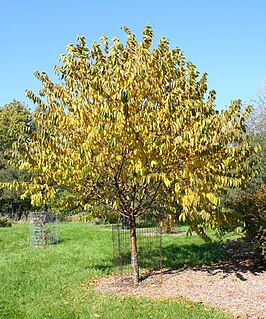
Prunus maximowiczii, known as Korean cherry, Korean mountain cherry, or Miyama cherry, is a small, fruiting cherry tree that can be found growing wild in northeastern Asia and Eurasia.
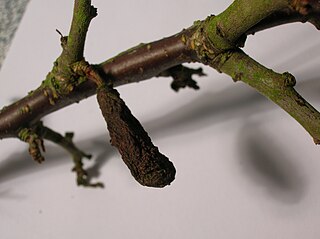
Taphrina pruni is a fungal plant pathogen of blackthorn that causes the pocket or bladder plum gall, a chemically induced distortion of the fruit (sloes), producing swollen on one side, otherwise deformed and flattened fruit gall without a stone. The twigs on infected plants may also be deformed with small strap-shaped leaves.

Taphrina padi is a fungal plant pathogen that induces the form of pocket plum gall that occurs on bird cherry. The gall is a chemically induced distortion of the fruits, which are swollen, hollow, curved and greatly elongated, without a seed or stone, but retaining the style. The twigs on infected plants may also be deformed with small strap-shaped leaves.
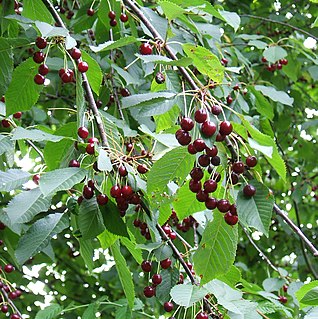
Prunus avium, commonly called wild cherry, sweet cherry, gean, or bird cherry is a species of cherry, a flowering plant in the rose family, Rosaceae. It is native to Europe, Anatolia, Maghreb, and Western Asia, from the British Isles south to Morocco and Tunisia, north to the Trondheimsfjord region in Norway and east to the Caucasus and northern Iran, with a small isolated population in the western Himalaya. The species is widely cultivated in other regions and has become naturalized in North America and Australia.

King cherry is a Korean native cherry tree originating from Jeju Island. It is a distinct species from Japanese native Yoshino cherry. King cherry is a rare plant and listed as an endangered species. As of April 2017, 194 King cherry trees were growing around Mt. Halla in Jeju Island. According to Gen-ichi Koidzumi, King cherry is erroneously believed to be discovered by a French missionary Emile Taquet although what he discovered was a different species.

Chrysozephyrus smaragdinus is a small butterfly found in the East Palearctic that belongs to the lycaenids or blues family.
Prunus tianshanica, the Tianshan cherry, is a species of cherry native to the Tianshan Mountains of Central Asia, preferring to grow at 800-1000 m.

Prunus subg. Cerasus is a subgenus of Prunus. Species of the subgenus have a single winter bud per axil. The flowers are usually in small corymbs or umbels of several together, but some species have short racemes. The fruit is a drupe and has no obvious groove along the side. The subgenus is native to the temperate regions of the Northern Hemisphere, with two species in North America, four in Europe, two in North Africa, and the remainder in Asia.
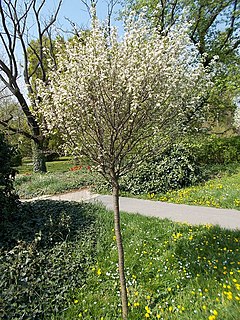
Prunus × eminens or Prunus eminens is a species of small cherry tree native to central Europe. It is a naturally occurring hybrid of sour cherry, Prunus cerasus, and dwarf cherry, Prunus fruticosa, occasionally found where their ranges overlap. Like its parents, it is a tetraploid with 32 chromosomes. It is forming a hybrid swarm with, and threatening to extirpate, P. fruticosa in much of its western range through genetic pollution.

















